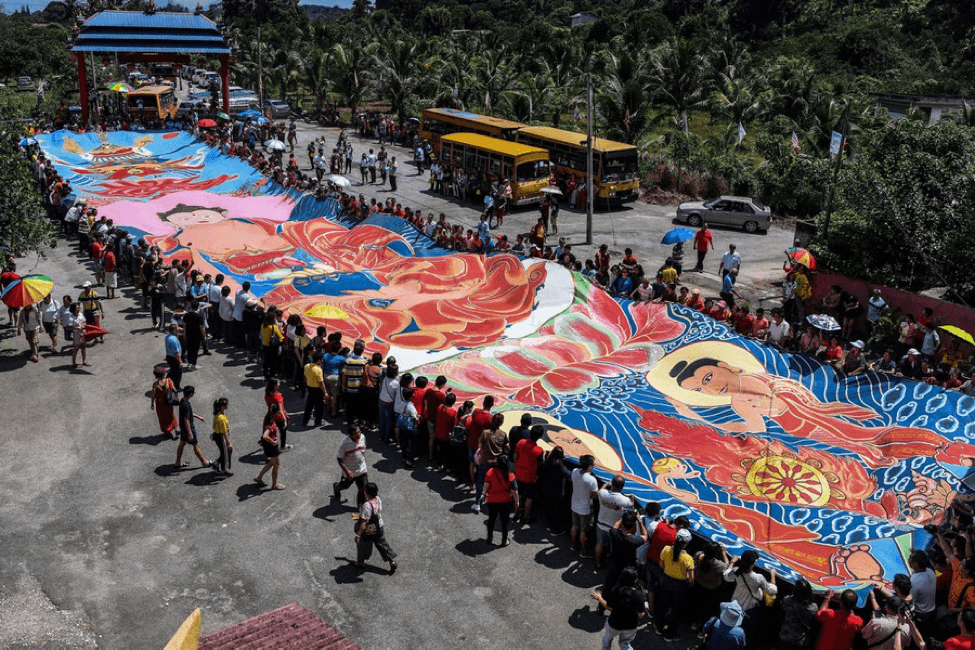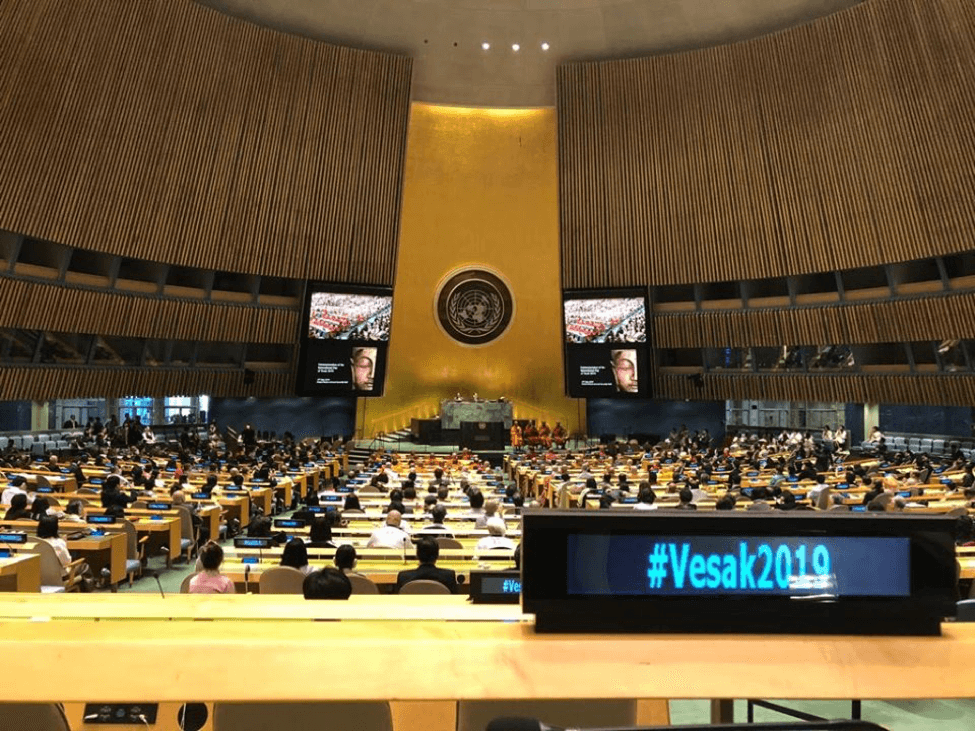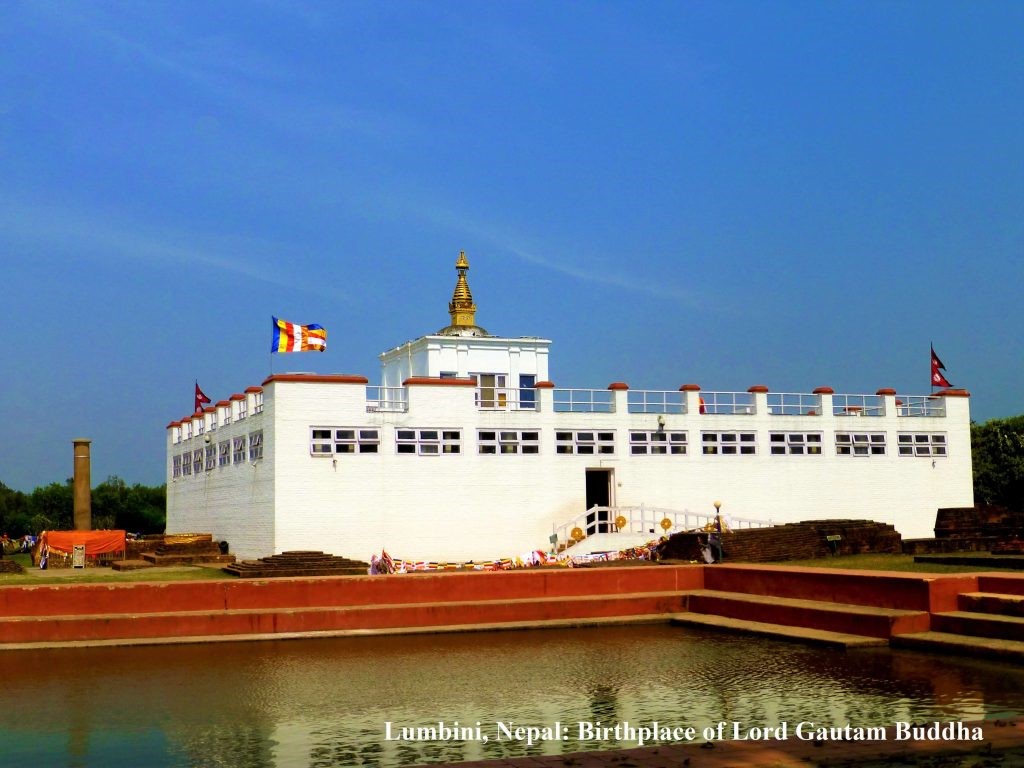
Three major events in the Buddha’s life – birth, enlightenment, and passing away – which constitute the Vesak Day celebration (photo credit: https://bit.ly/3saDrN6)
What is Vesak Day?
Vesak Day, the holiest day in Buddhism, sees the full moon of the month of May, and celebrates the birth, enlightenment (or awakening), and death of the Buddha (known as parinirvana in Pali). It is a celebration that is an expression of gratitude for the legacy that the Buddha left behind — Buddhism — and it can also be a propelling force for us to do good for ourselves and others. Vesak Day is also known by other names, e.g. Buddha Jayanti, Buddha Purnima, and Buddha Day in India, or Visakha Buja Day in Thailand.
Who was the Buddha?
The word “Buddha” means “the Enlightened One” or “the Awakened One.” It is not a proper name but a title given to one who has attained enlightenment, which was what happened to Siddhatha Gotama, who lived more than 25 centuries ago. Siddhatha was born on the full moon day in the month of May in modern-day Nepal as a prince to a royal family of the Sakyan Kingdom, at the foot of the Himalayas. Siddhattha’s father was King Suddhodana, and his mother was Queen Maya. Siddhattha married princess Yasodhara or Bimbadevi or Gopa, his cousin of the same age, who bore him a son, Rahula, at the age of 29.

Archaeological work has uncovered the ancient city of Kapilavastu, now known as Tilaurakot in Nepal (photo credit: https://bit.ly/3KBgYiq)

The Maya Devi Temple (or Lumbini Temple) was built at the place where Prince Siddhattha was born at Lumbini, UNESCO world heritage site (photo by the courtesy of Embassy of Nepal in Bangkok).

Archeological excavations inside and underneath the Maya Devi Temple reveal layers of earlier temples dating from 6th century B.C. (photo credit: https://bit.ly/3MJPKHP)

(Photo credit: https://bit.ly/3vAt3QG)
Since childhood, Siddhattha was very compassionate and clever. He studied the subjects necessary to become a good ruler. In addition, he learned major scriptures in Brahmanism/Hinduism, informing himself of topics such as the Four Vedas, the Six Vedangas, and the Upanishads. He was particularly fascinated with the doctrines of samsara (rebirth or reincarnation), moksha (liberation from the cycle of birth and death), and Atman (self) in the Upanishads. Despite his father’s desire for him to be attached to the world and satisfied with the enjoyment of sensual pleasures, Siddhatha was preoccupied with a desire to solve the problem of samsara, asking: How can one liberate oneself from the cycle of birth or rebirth, which involves death again and again, and how can one help other people to be free from samsara?
Enthusiastically, at the age of 29, Siddhattha asked for his wife’s and father’s permission to leave his family and the palace. He told his wife, “… Though I will be gone, though I will be far away from you, my love for you will remain the same. I will never stop loving you… And when I have found the Way, the answer to his question, I will return to you and to our child.” He also promised his father, “I will never abandon you. I am only asking you to let me go away for a time. When I have found the Way, I will return.” Siddhattha then left his family and became a wandering religious mendicant (Pali: paribbajaka) to find the Way. After six years of studies, including an experiment in the forest inspired by Brahmani ascetism – which he had hypothesized was key – Siddhattha realized that asceticism was not the answer. He gave up ascetic practices, intending for a rational, simple life of moderation instead.
On the night of the full moon in the month of May, forty-five years before the Buddhist Era, Siddhattha, sitting under a peepal tree, underwent great progress in his search, and an omniscient illumination came over him. That night, under the tree, he achieved enlightenment, finally understanding the origins of suffering and rebirth, and how to end it. He said, as quoted in Dr. Hermann Oldenberg’s Buddha: His Life, his Doctrine, His Order, “When I apprehended this, and when I beheld this, my soul was released from the evil of desire, released from the evil of earthly existence, released from the evil of error, released from the evil of ignorance. In the released awoke the knowledge of release: extinct is re-birth, finished the sacred course, duty done, no more shall I return to this world; this I knew.”

Mahabodhi Stupa, a UNESCO World Heritage Site, in the Mahabodhi Temple Complex built to mark the place of the Buddha’s enlightenment in modern-day Bihar (photo credit: https://bit.ly/3LCwwnm)

The main Buddha statue inside the Mahabodhi Stupa (photo credit: https://bit.ly/3y3qQz1)

The fourth generation of the peepal (later called Bodhi) tree under which the Buddha sat on the night of enlightenment is just behind the Mahabodhi stupa (photo credit: https://bit.ly/3KrGcQo)
For the next forty-five years of his life, from the ages of 35 to 80, the Buddha would travel from place to place to teach all who would listen. He organized his followers, who similarly renounced the material world, to form the Sangha.
At the age of 80, however, the Buddha fell ill while on his way to Kusinara (modern-day Kushinagar), capital of the ancient Malla State. In his deathbed under two Sal trees in the Sal Grove of the Mallas, he told his disciples that they would not be left without “the Teacher”: “The Doctrine and Discipline I have taught you, that shall be your teacher when I am gone… Behold now, monks, I exhort you. Subject to decay are all component things. Work out your salvation with diligence.” He passed away on the day of the full moon in the month of May.

The Mahaparinibbana temple (or Mahaparinirvana in Sanskrit and Hindi, on the right) and stupa were built to mark the place of the Buddha’s death at modern-day Kushinagar in Uttar Pradesh, India (photo credit: a Thai Buddhist monk in India)

The statue of dying Buddha inside the Mahaparinirvana Temple at Kushinagar (photo courtesy of Mr. Teeravas Bumpenbunbaramee)
What was the Buddha’s Legacy?
The Buddha’s teachings are his legacy. They are called Dhamma in Pali (Dharma in Sanskrit) and translate to the truth of things – the way things are. It also refers to the teachings that illuminate that truth, detailing the path leading to the direct experience of it.
Examples of the Buddha’s teachings include:
- The Five Precepts
- The Discourse on Prosperity and Happiness (Mangala Sutta in Pali),
- Kamma
- The Four Noble Truths
- The Noble Eightfold Path
- Meditation (you may read how to meditate on Thailandfoundation.or.th here as well).
Following his teachings, believers may find the essence of Buddhism, which is to abandon non-virtuous deeds, to cultivate virtuous deeds, and to purify the mind. One must not be enslaved by negative thoughts and maintain a peaceful and happy mind. (The BBC’s article here, and the scholarly treatise Buddhadhamma: The Law of Natures and Their Benefits to Life by Bhikkhu P.A. Payutto provide easily understandable texts for further reading on Buddhism.)
Celebrating Vesak Day
Vesak Day celebrations may vary in countries. Some Buddhists in India, Indonesia, Japan, Malaysia, Mongolia, Singapore, Sri Lanka, and Vietnam may light candles and put up decorations, while Japanese and Chinese Buddhists may bathe a statue of the Buddha in scented water.

Vietnamese monks during Vesak prayers in Vietnam (photo credit: https://bit.ly/3Ft6e53)

A Buddhist monk releases a lantern at Borobudur temple during celebrations for Vesak Day in Indonesia (photo credit: https://bit.ly/3ycG70h)

Light decoration in Vesak Day celebration in Sri Lankans (photo credit: https://bit.ly/3FdL9v2)

Malaysian Buddhists unfurl a 25-year-old, 196-foot-long devotional painted cloth during Vesak festival celebrations at the Enlightened Heart Tibetan Buddhist Temple in Ipoh, outside Kuala Lumpur, Malaysia, on May 19, 2019 (photo credit: https://bit.ly/3ORvXIk)

Bathing the infant Buddha statue on Vesak Day in Japan (photo credit: https://bit.ly/3saADPS)

Day of Vesak celebrated at the UN Headquarters in New York in 2019 (photo credit: https://bit.ly/38E40mO)
In Thailand, where Vesak Day is known as Visakha Buja Day, Buddhists usually make merit by going to temples, vowing to keep the layman’s precepts, offering food to monks, and listening to Dhamma Talks. And in the afternoon or evening, they may again go to temples to join a procession filled with flowers, incense sticks, and candles, walking around the chapel.

The King of Thailand is celebrating Visakha Bucha Day by walking around the main chapel housing the Buddha at Temple of the Emerald Buddha in Bangkok (photo credit: https://yhoo.it/3ku4L4M)

Thai monks prepare to lead a procession to walk clockwise round a building housing the Buddha image three times at a temple in Thailand on Visakha Bucha Day (photo credit: https://yhoo.it/3MC5Ymm)

Thai Buddhists celebrate Visakha Bucha by circumambulating the main chapel at the Marble Temple in Bangkok (photo credit: https://bit.ly/3s8fnKQ)
However, celebrating Visakha Bucha Day also means making special efforts to bring happiness to the unfortunate and the needy, for instance the aged, the handicapped, and the sick. To this day, Buddhists will distribute gifts in cash and kind to various charitable homes throughout the country.

The Thai Red Cross Society invites people to donate blood on Visakha Bucha Day
(photo credit: https://bit.ly/3MR3PmU)
On Vesak Day this year, I would like to invite readers to join around 500 million Buddhists across the globe in celebrating the Buddha’s birth, enlightenment, and death. By walking on the path to happiness for ourselves as well as for others, practicing compassion for ourselves as well as for others, forgiving ourselves as well as others, we may find a peaceful co-existence with people of different faiths — tolerance and welcome being essential for peace. In this way, we truly celebrate Vesak Day. The Buddha ensures that we can do this; he said, “He is able who think he is able”.
Major references:
- Ajahn Jayasaro. Without and Within: Questions and Answers on the Teachings of Theravada Buddhism. Amarin printing and publishing Plc. 2014.
- Harris, Ian Ph.D. The Complete Illustrated Encyclopedia of Buddhism. HH Hermes House.
Author: Paitoon Songkaeo, Ph.D.
9 May 2022[:th]
ภาพวาดพระพุทธเจ้าประสูติ ตรัสรู้ และปรินิพพาน อันเป็นที่มาของวันวิสาขบูชา (ภาพจาก https://bit.ly/3saDrN6)
วันวิสาขบูชาคือวันอะไร
วันวิสาขะคือวันขึ้น 15 ค่ำอยู่ในช่วงเดือนเมษายน-พฤษภาคมตามจันทรคติ เป็นวันเพ็ญเดือน 6 ที่ชาวพุทธเราฉลองเพื่อรำลึกการประสูติ ตรัสรู้ และปรินิพพานของพระพุทธเจ้า ซึ่งถือเป็นวันสำคัญที่สุดในพระพุทธศาสนา ชาวพุทธจะแสดงออกถึงความกตัญญูกตเวทีต่อพระพุทธเจ้าผู้ที่ได้ทรงประทานพุทธธรรมไว้ให้ และชาวพุทธเราได้ดำเนินชีวิตเพื่อประโยชน์สุขของตนเองและผู้อื่นไปพร้อม ๆ กันตามแนวคำสอนที่ประเสริฐของพระพุทธองค์
คำว่า “วิสาขะ” นี้ในภาษาอังกฤษอาจพบที่เขียนกันอยู่หลายแบบ เช่น Vesak ซึ่งใช้กันแพร่หลายที่สุดในโลก Vesakha และ Vaishakha ส่วนในประเทศอินเดียและเนปาลมักเรียกวันวิสาขะว่าพุทธชยันตี (Buddha Jayanti) แปลว่า วันที่ระลึกถึงวันประสูติของพระพุทธเจ้าบ้าง พุทธปุรณิมา (Buddha Purnima) หมายถึงการบูชาพระพุทธเจ้าในวันเพ็ญเดือนวิสาขะบ้าง หรือเรียกรวม ๆ กันว่าวันพระพุทธเจ้าบ้าง (Buddha Day) ส่วนในประเทศไทยเราเรียกกันว่าวันวิสาขบูชา (Visakha Buja Day)
นับตั้งแต่ พ.ศ. 2543 เป็นต้นมาองค์การสหประชาชาติได้จัดงานฉลองวันวิสาขะที่สำนักงานใหญ่ขององค์การฯ ในมหานครนิวยอร์ก ประเทศสหรัฐอเมริกา เป็นประจำทุกปีเพื่อน้อมรำลึกถึงพระมหากรุณาธิคุณของพระพุทธเจ้าที่มีต่อโลกด้วย
พระพุทธเจ้าคือใคร
คำว่า พุทธะ แปลว่า ผู้ตรัสรู้ (Enlightened One หรือ Awakened One) ไม่ใช่เป็นชื่อจริง แต่เป็นสมญานามที่ในประวัติศาสตร์ของโลกได้กราบถวายแด่มหาบุรุษผู้ฉลาดหลักแหลมยิ่งจนสามารถรู้แจ้งถึงวิธีดับทุกข์สร้างสุขแทนได้ มหาบุรุษท่านนี้คือเจ้าชายสิทธัตถะผู้ได้ถือครองเพศนักบวชเมื่อพระชนมายุ 29 พรรษาแล้วเสาะแสวงหาจนพบโมกขธรรม (หรือโมกษธรรม หรืออมตธรรม) เมื่อพระชนมายุ 35 พรรษา หลังจากนั้นก็ทรงได้รับการถวายพระนามว่าพุทธะหรือพระพุทธเจ้า
พระโพธิสัตว์สิทธัตถะประสูติในวันเพ็ญเดือนวิสาขะ เป็นพระโอรสของพระเจ้าสุทโทธนะและพระนางสิริมหามายา ผู้ครองแคว้นศากยะ (อยู่ในประเทศเนปาลปัจจุบัน) มีกบิลพัสดุ์เป็นเมืองหลวง แคว้นศากยะตั้งอยู่บริเวณเชิงเทือกเขาหิมาลัย
 การขุดค้นทางโบราณคดีทำให้พบซากเมืองกบิลพัสด๋ ซึ่งปัจจุบันชื่อติเลาราโกฏ (Tilaurakot) อยู่ในประเทศเนปาล (ภาพจาก https://bit.ly/3KBgYiq)
การขุดค้นทางโบราณคดีทำให้พบซากเมืองกบิลพัสด๋ ซึ่งปัจจุบันชื่อติเลาราโกฏ (Tilaurakot) อยู่ในประเทศเนปาล (ภาพจาก https://bit.ly/3KBgYiq)
 วัดพระนางมายา (Maya Devi Temple หรือ Lumbini Temple) สร้างคร่อมสถานที่ประสูติเจ้าชายสิทธัตถะที่ลุมพินี (Lumbini) ซึ่งปัจจุบันเป็นแหล่งมรดกโลกด้วย (UNESCO world heritage site) (เอื้อเฟื้อภาพโดยสถานเอกอัครราชทูตเนปาลที่กรุงเทพฯ)
วัดพระนางมายา (Maya Devi Temple หรือ Lumbini Temple) สร้างคร่อมสถานที่ประสูติเจ้าชายสิทธัตถะที่ลุมพินี (Lumbini) ซึ่งปัจจุบันเป็นแหล่งมรดกโลกด้วย (UNESCO world heritage site) (เอื้อเฟื้อภาพโดยสถานเอกอัครราชทูตเนปาลที่กรุงเทพฯ)
 การขุดค้นทางโบราณคดีในวัดพระนางมายาได้พบชั้นดินก่อสร้างเก่า ๆ หลายชั้น บางชั้นเก่าแก่ถึงสมัยพุทธกาล (ภาพจาก https://bit.ly/3MJPKHP)
การขุดค้นทางโบราณคดีในวัดพระนางมายาได้พบชั้นดินก่อสร้างเก่า ๆ หลายชั้น บางชั้นเก่าแก่ถึงสมัยพุทธกาล (ภาพจาก https://bit.ly/3MJPKHP)
 (ภาพจาก https://bit.ly/3vAt3QG)
(ภาพจาก https://bit.ly/3vAt3QG)
ตั้งแต่ยังทรงพระเยาว์ พระโพธิสัตว์สิทธัตถะเป็นราชกุมารที่ฉลาดหลักแหลม (prodigy) มีพระอุปนิสัยอ่อนโยนและมีพระกรุณาสูงมาก
ในฐานะเจ้าชายได้ทรงศึกษาศิลปะวิทยาหลายแขนงเพื่อเตรียมตัวเป็นผู้ปกครองที่สามารถ และในขณะเดียวกันก็ทรงศึกษาคัมภีร์ในศาสนาพราหมณ์/ฮินดูด้วย เช่น คัมภีร์พระเวท (Vedas) คัมภีร์เวทางค์ (Vedangas) และคัมภีร์อุปนิษัท (Upanishads) ซึ่งในคัมภีร์อุปนิษัทนี้เองพระองค์ทรงสนพระทัยหลายเรื่อง เช่น เรื่องวงจรการตายแล้วเกิด เกิดแล้วตาย อย่างไม่มีที่สิ้นสุด (สังสารวัฏ) และเรื่องการหลุดพ้นจากสังสารวัฏ (ภาษาบาลีเรียกว่าโมกขะ หรือภาษาสันสกฤตเรียกว่าโมกษะ moksha)
พระเจ้าสุทโธทนะได้จัดสรรสิ่งบำรุงบำเรอต่าง ๆ นานาให้เจ้าชายสิทธัตถะเพื่อให้สนใจการใช้ชีวิตทางโลกมากกว่าทางธรรม ด้วยทรงหวังจะให้พระโอรสเป็นผู้ปกครองเหมือนพระองค์ เช่น มีตำหนักให้ประทับสามหลังสำหรับสามฤดู เป็นต้น แต่เจ้าชายสิทธัตถะกลับสนพระทัยเรื่องโมกขะมากกว่า คือ การแก้ปัญหาว่าทำอย่างไรจึงจะตายแล้วไม่เกิดอีก หรือหลุดพ้นจากสังสารวัฏ
เมื่อพระชนมายุ 16 พรรษา พระเจ้าสุทโธทนะกับพระนางสิริมหามายาก็จัดให้เจ้าชายสิทธัตถะทรงเข้าพิธีวิวาห์กับเจ้าหญิงยโสธรา (หรือพิมพา หรือโคปา) และเมื่อพระชนมายุ 29 พรรษาทรงมีพระโอรสด้วยกันพระนามว่าราหุล
เมื่อพระชนมายุ 29 พรรษานี้เอง เจ้าชายสิทธัตถะได้ขออนุญาตพระชายากับพระบิดาและพระมารดาเพื่อไปใช้ชีวิตแบบนักบวชเพื่อแสวงหาโมกขะ พระองค์ตรัสกับพระนางพิมพาว่า “แม้จะต้องจากเจ้าไป จะไม่ได้อยู่เคียงข้าง แต่ความรักที่มีต่อเจ้าจะยังคงเหมือนเดิม จะรักเจ้าตลอดไป และเมื่อเราพบโมกขะแล้ว จะรีบนำเอากลับมาหาเจ้าและลูกรักของเรา” พระองค์ก็กราบบังคมทูลขอพระราชานุญาตทำนองเดียวกันว่า “ลูกไม่มีวันทิ้งพระบิดาและพระมารดา ลูกเพียงขอพระราชานุญาตไปใช้ชีวิตแบบนักบวชเพื่อแสวงหาโมกขะเท่านั้น ทันทีที่พบโมกขะ ลูกจะรีบกลับมา”[i]
หลังจากนั้น พระโพธิสัตว์สิทธัตถะก็เสด็จออกไปใช้ชีวิตแบบนักบวชเพื่อแสวงหาโมกขะ ทรงศึกษาเพิ่มเติมกับพระอาจารย์ตามสำนักต่าง ๆ และทรงทดลองภาคปฏิบัติแนวทางสำหรับโมกษะอย่างจริงจังยิ่ง (ทุกกรกิริยา) อยู่ 6 ปี ก็ทรงประจักษ์ว่าแนวทางที่ปฏิบัติอยู่นั้นไม่ใช่แนวทางที่ถูกต้องสำหรับโมกขะ (อาจเปรียบเหมือนกับการทดลองทางวิทยาศาสตร์ที่มักจะต้องพบก่อนว่าวิธีการที่ทำการทดลองอยู่นั้นไม่ใช่วิธีที่ถูกต้อง ไม่ได้ผลตามที่ต้องการ แล้วนักวิทยาศาสตร์ที่ยิ่งใหญ่ก็จะคิดค้นหาทดลองวิธีอื่น ๆ ต่อไป จนกว่าจะประสบความสำเร็จ) ทรงเลิกทำทุกกรกิริยา เปลี่ยนไปทำสมาธิมากขึ้น และเสวยพระกระยาหารแต่พอประมาณเพื่อให้พระวรกายไม่อ่อนแอและจิตเป็นสมาธิได้ง่ายขึ้น
เมื่อถึงวันขึ้น 15 ค่ำในเดือนวิสาขะทรงนั่งใต้ต้นปีปัลแล้วตั้งพระทัยแน่วแน่ที่จะนั่งทำสมาธิไปเรื่อย ๆ จนกว่าจะพบโมกขะ
ทั้งนี้ ต้นไม้ที่พระองค์ทรงนั่งอธิษฐานจิตที่โคนนี้เรียกในภาษาอินเดียพื้นเมืองว่า “ปีปัล” และต่อมาเรียกว่าต้นโพธิ – ซึ่งเป็นคำที่มาจากภาษาบาลีว่า โพธิ หรือโพธิญาณ หรือสัมโพธิญาณ หรือสัมมาสัมโพธิญาณ ที่ล้วนหมายถึงการรู้แบบค้นพบลักษณะนี้เป็นคนแรก
เหตุการณ์สำคัญยิ่งในคืนวันเพ็ญเดือนวิสาขะอาจกล่าวโดยสรุปได้ว่า เมื่อทรงตั้งพระทัยที่จะค้นให้พบโมกขะแล้ว (ทั้งนี้ โมกขะคือการหลุดพ้นจากการเวียนว่ายตายเกิด ตายแล้วจะไม่เกิดอีก อาจเรียกว่าอมตธรรมก็ได้ ซึ่งหมายถึงความรู้ที่ทำให้ตายแล้วไม่เกิดอีก) ก็ทรงนั่งทำสมาธิจนจิตใจสงบรวมตัวเป็นพลังได้มากแล้ว จึงส่งกระแสพลังจิตไปดูอดีตชาติต่าง ๆ ที่นับไม่ถ้วนของพระองค์เอง คือ เคยเกิดเป็นสิ่งมีชีวิตในรูปแบบใดรูปแบบหนึ่งแล้วตาย แล้วเกิดเป็นสิ่งมีชีวิตในรูปแบบใดรูปแบบหนึ่งอีก เวียน ๆ ซ้ำ ๆ กันอยู่อย่างนี้ จนนับไม่ถ้วน (เรียกว่าทรงบรรลุปุพเพนิวาสานุสสติญาณ) ต่อจากนั้น ก็ทรงส่งกระแสพลังจิตไปดูการเกิดและตายลักษณะเดียวกันนี้ของสิ่งมีชีวิตอื่น ๆ บ้าง ก็ทรงเห็นได้มากมายตราบเท่าที่ทรงประสงค์จะเห็น (เรียกว่าทรงบรรลุจุตูปปาตญาณ) และในท้ายที่สุดทรงส่งพลังจิตไปหาจนพบปฐมเหตุว่าที่เวียนว่ายตายเกิดกันอยู่นั้นพราะยังมีราคะ โทสะ โมหะ จึงทำกรรมทั้งดีและชั่วปะปนกัน จึงเกิดแล้วตาย ตายแล้วเกิดอยู่อย่างไม่มีที่สิ้นสุด เกิดดีบ้าง เกิดเลวบ้าง ถ้าจะตายแล้วไม่ต้องเกิดอีก จะต้องละราคะ โทสะ และโมหะให้ได้ (เรียกว่าทรงบรรลุอาสวักขยญาณ)
เมื่อทรงบรรลุอาสวักขยญาณนี้ พระองค์ตรัสว่าเราได้ทรงค้นพบโมกขะหรืออมตธรรมแล้ว และเมื่อดับขันธ์ปรินิพพาน (คือ การตายของพระพุทธเจ้า) แล้วพระองค์จะไม่เกิดอีก ชาตินี้เป็นชาติสุดท้ายของพระองค์
พวกเราชาวพุทธเรียกการค้นพบอมตธรรมนี้ว่าพระพุทธเจ้าทรงตรัสรู้ซึ่งมีในคืนวันขึ้น 15 ค่ำเดือนวิสาขะ
 พระมหาโพธิสถูปเป็นพระสถูปประธานในวัดมหาโพธิ (Mahabodhi Temple Complex) ที่สร้างขึ้นบนสถานที่ตรัสรู้ของพระพุทธเจ้าในรัฐพิหาร (ในสมัยพุทธกาลเรียกว่าแคว้นมคธ) ซึ่งเป็นแหล่งมรดกโลกด้วย (ภาพจาก https://bit.ly/3LCwwnm)
พระมหาโพธิสถูปเป็นพระสถูปประธานในวัดมหาโพธิ (Mahabodhi Temple Complex) ที่สร้างขึ้นบนสถานที่ตรัสรู้ของพระพุทธเจ้าในรัฐพิหาร (ในสมัยพุทธกาลเรียกว่าแคว้นมคธ) ซึ่งเป็นแหล่งมรดกโลกด้วย (ภาพจาก https://bit.ly/3LCwwnm)
 ภายในพระมหาโพธิสถูปเป็นที่ประดิษฐานพระพุทธรูปที่ชาวพุทธจำนวนมากจากทั่วโลกมาสักการะบูชาในแต่ละวัน (ภาพจาก https://bit.ly/3y3qQz1)
ภายในพระมหาโพธิสถูปเป็นที่ประดิษฐานพระพุทธรูปที่ชาวพุทธจำนวนมากจากทั่วโลกมาสักการะบูชาในแต่ละวัน (ภาพจาก https://bit.ly/3y3qQz1)
 ต้นโพธิที่เชื่อกันว่าเกิดตายต่อกันมาเป็นรุ่นที่ 4 แล้วซึ่งพระพุทธเจ้าทรงประทับนั่งตรัสรู้อยู่หลังติดกับพระมหาโพธิสถูป (ภาพจาก https://bit.ly/3KrGcQo)
ต้นโพธิที่เชื่อกันว่าเกิดตายต่อกันมาเป็นรุ่นที่ 4 แล้วซึ่งพระพุทธเจ้าทรงประทับนั่งตรัสรู้อยู่หลังติดกับพระมหาโพธิสถูป (ภาพจาก https://bit.ly/3KrGcQo)
หลังจากตรัสรู้แล้ว พระพุทธเจ้าทรงเที่ยวสั่งสอนแนวทางการดำเนินชีวิตที่ดีกว่าตั้งแต่ธรรมะสำหรับฆราวาสใช้ในการดำเนินชีวิตปกติให้มีความสุข ความสำเร็จ และเป็นประโยชน์ต่อสังคมส่วนรวมจนถึงอมตธรรมสำหรับนักบวชอยู่เป็นเวลา 45 ปี ทรงตั้งชุมชนตัวอย่างขึ้นมาเรียกว่าชุมชนพุทธ (พุทธสาวก) ซึ่งประกอบด้วยนักบวชผู้ชาย (ภิกษุและสามเณร) นักบวชผู้หญิง (ภิกษุณีและสามเณรี) ฆราวาสชาย (อุบาสก) และฆราวาสหญิง (อุบาสิกา) แล้วทรงวางกฎให้สมาชิกของชุมชนต้องปฏิบัติ เช่น อุบาสกและอุบาสิกาต้องมีศีล 5 สามเณรต้องมีศีล 10 พระภิกษุต้องมีศีล 227 ข้อ พร้อมกับทรงชี้แนะแนวทางการดำเนินชีวิตที่ดีประเสริฐ (ธรรมะ) ต่าง ๆ มากมาย เป็นต้น
เมือพระชนมายุ 80 พรรษา พระองค์ทรงปรินิพพานในสวนต้นสาละ (สาลวโนทยาน) ที่เมืองกุสินารา (ปัจจุบันเป็นอำเภอเรียกว่ากุศินคร Kushinagar) อยู่ในรัฐอุตตรประเทศ ประเทศอินเดีย) โดยในขณะที่ทรงประทับอยู่บนเตียงปรินิพพานนั้น ได้ตรัสบอกความจริงของชีวิตและให้กำลังใจแก่เหล่าสาวกเป็นครั้งสุดท้ายว่ากฎและธรรมะสำหรับการใช้ชีวิตที่ดีประเสริฐที่พระองค์ได้ชี้แนะพร่ำสอนมาตลอดนั้นจะเป็นครูอาจารย์แทนพระองค์ตลอดไป และขอให้เหล่าสาวกรู้ว่าร่างกายของคนเรานั้นต้องเสื่อมต้องสิ้นไปเป็นธรรมดา ไม่คงอยู่ถาวรได้ ดังนั้น ในขณะที่ยังมีชีวิตอยู่ขอให้ตั้งใจใช้ชีวิตอย่างมีสติทำดีทุกเมื่อ อย่าได้ประมาทเด็ดขาด เพราะถ้าทำได้อย่างนี้ ทุกคนก็จะสามารถบรรลุอมตธรรมได้ดังหวัง
พระพุทธเจ้าทรงปรินิพพานในวันเพ็ญของเดือนวิสาขะเช่นกัน
 วัดมหาปรินิพพาน (Mahaparinibbana temple อาคารเตี้ย) และพระสถูปยุคใหม่สร้างอยู่ในสวนที่เป็นที่ปรินิพพานของพระพุทธเจ้าที่เมืองกุศินคร ประเทศอินเดีย (เอื้อเฟื้อภาพโดยพระสงฆ์ไทยในอินเดีย )
วัดมหาปรินิพพาน (Mahaparinibbana temple อาคารเตี้ย) และพระสถูปยุคใหม่สร้างอยู่ในสวนที่เป็นที่ปรินิพพานของพระพุทธเจ้าที่เมืองกุศินคร ประเทศอินเดีย (เอื้อเฟื้อภาพโดยพระสงฆ์ไทยในอินเดีย )
 พระพุทธรูปปางปรินิพพานประดิษฐานอยู่ในพระสถูป (เอื้อเฟื้อภาพโดยนายธีรวัส บำเพ็ญบุญบารมี)
พระพุทธรูปปางปรินิพพานประดิษฐานอยู่ในพระสถูป (เอื้อเฟื้อภาพโดยนายธีรวัส บำเพ็ญบุญบารมี)
อะไรคือพุทธมรดก
คำสั่งสอนของพระพุทธเจ้าคือพุทธมรดก หรือจะกล่าวว่าพระพุทธศาสนาคือพุทธมรดกก็ได้ หรือจะเรียกว่าธรรมะเฉย ๆ ก็น่าจะยังได้ คำว่าธรรมะในที่นี้หมายถึงสองอย่าง คือ สภาวะความจริงตามที่มันเป็น และคำสอนของพระพุทธเจ้าที่ชี้แนะความจริงเหล่านั้นจนผู้ปฏิบัติสามารถมีประสบการณ์ที่ดีกับความจริงเหล่านั้นได้
คำสอนของพระพุทธเจ้ามีมากกว่า 80,000 เรื่อง ขอยกมากล่าวถึงเฉพาะหัวข้อ 6 เรื่องเท่านั้น คือ
- ศีล 5 ที่ชาวพุทธฆราวาสทั้งชายและหญิงต้องมีในการดำเนินชีวิต (Five Precepts)
- วิธีสร้างความสำเร็จและความสุขทั้งต่อตนเองและผู้อื่นจำนวน 38 วิธี (Mangala Sutta)
- กรรม (Kamma)
- อริยสัจ 4 (Four Noble Truths)
- มรรค 8 (Noble Eightfold Path)
- การทำสมาธิ (Meditation) ทั้งนี้ ผู้อ่านอาจอ่านเรื่องนี้เพิ่มเติมได้ที่เว็บไซต์ของมูลนิธิไทย (Thailandfoundation.or.th) ที่นี้
นอกจากนี้ ผู้อ่านอาจอ่านสรุปสาระสำคัญของพระพุทธศาสนาได้ที่นี้ ซึ่งมี 3 ประเด็น คือ การไม่ทำบาปทั้งปวง การทำบุญกุศลให้มากขึ้น และการค่อย ๆ ลดความรู้สึกไม่ดีทั้งหลายทั้งปวงจนสามารถชำระจิตใจให้สะอาดหมดจดได้ กล่าวอีกอย่างหนึ่งก็คือจิตใจต้องไม่ตกเป็นทาสของความคิดฝ่ายบาปอกุศล โดยต้องมีความรู้สึกสงบและเป็นสุขให้ได้มากที่สุดจนตลอดเวลาได้ก็ยิ่งดี (ผู้อ่านอาจอ่านบทความสั้น ๆ เกี่ยวกับพระพุทธศาสนาในเว็บไซต์ของบีบีซีได้ที่นี้ และหนังสือ “พุทธรรม” โดยสมเด็จพระพุทธโฆษาจารย์ (ป.อ. ปยุตฺโต) ได้ที่นี้
การฉลองวันวิสาขบูชา
ประเทศต่าง ๆ ที่นับถือพระพุทธศาสนาจะจัดงานวิสาขบูชา แต่รูปแบบของงานอาจแตกต่างกันบ้าง เช่น ชาวพุทธในประเทศอินเดีย อินโดนีเซีย ญี่ปุ่น มาเลเซีย มองโกเลีย สิงคโปร์ ศรีลังกา และเวียดนาม อาจจุดเทียนบูชาพระพุทธเจ้า หรือไม่ก็ทำประทีบโคมไฟปล่อยขึ้นสู่ท้องฟ้า ส่วนชาวพุทธญี่ปุ่นและชาวพุทธจีนอาจฉลองวันวิสาขบูชาด้วยการสรงน้ำพระพุทธรูป เป็นต้น
 พระภิกษุชาวเวียดนามกำลังนำชาวพุทธเวียดนามประกอบพิธีวิสาขบูชาที่ประเทศเวียดนาม (ภาพจาก https://bit.ly/3Ft6e53)
พระภิกษุชาวเวียดนามกำลังนำชาวพุทธเวียดนามประกอบพิธีวิสาขบูชาที่ประเทศเวียดนาม (ภาพจาก https://bit.ly/3Ft6e53)
 พระภิกษุกำลังปล่อยโคมไฟในงานวิสาขบูชาที่บริเวณเจดีย์บรมพุทโธในประเทศอินโดนีเซีย (ภาพจาก https://bit.ly/3ycG70h)
พระภิกษุกำลังปล่อยโคมไฟในงานวิสาขบูชาที่บริเวณเจดีย์บรมพุทโธในประเทศอินโดนีเซีย (ภาพจาก https://bit.ly/3ycG70h)
 ไฟประดับติดตั้งตามสถานที่ต่าง ๆ ในประเทศศรีลังกาเพื่อฉลองวันวิสาขบูชา (ภาพจาก https://bit.ly/3FdL9v2)
ไฟประดับติดตั้งตามสถานที่ต่าง ๆ ในประเทศศรีลังกาเพื่อฉลองวันวิสาขบูชา (ภาพจาก https://bit.ly/3FdL9v2)
 ชาวพุทธมาเลเซียกำลังช่วยกันขึงผ้าภาพวาดทางพระพุทธศาสนาในงานวันวิสาขบูชาที่วัดธิเบตนอกกรุงกัวลาลัมเปอร์ ประเทศมาเลเซีย เมื่อวันที่ 19 พฤษภาคม พ.ศ. 2562 (ภาพจาก https://bit.ly/3ORvXIk)
ชาวพุทธมาเลเซียกำลังช่วยกันขึงผ้าภาพวาดทางพระพุทธศาสนาในงานวันวิสาขบูชาที่วัดธิเบตนอกกรุงกัวลาลัมเปอร์ ประเทศมาเลเซีย เมื่อวันที่ 19 พฤษภาคม พ.ศ. 2562 (ภาพจาก https://bit.ly/3ORvXIk)

ชาวญี่ปุ่นนิยมสรงน้ำพระพุทธรูปในวันวิสาขบูชา (ภาพจาก https://bit.ly/3saADPS)
 ปัจจุบันองค์การสหประชาชาติได้จัดงานวันวิสาขบูชาที่สำนักงานใหญ่ขององค์การฯ ที่มหานครนิวยอร์ก ประเทศสหรัฐอเมริกาด้วย (ภาพจาก https://bit.ly/38E40mO)
ปัจจุบันองค์การสหประชาชาติได้จัดงานวันวิสาขบูชาที่สำนักงานใหญ่ขององค์การฯ ที่มหานครนิวยอร์ก ประเทศสหรัฐอเมริกาด้วย (ภาพจาก https://bit.ly/38E40mO)
สำหรับประเทศไทย ชาวพุทธไทยเราให้ความสำคัญกับวันวิสาขบูชามาก ส่วนใหญ่จะไปวัดทำบุญกันตั้งแต่เช้า มีการรับศีลจากพระ ตักบาตรพระสงฆ์หรือไม่ก็ถวายอาหารเช้าแด่พระ และฟังเทศน์ พอถึงเวลาบ่ายหรือไม่ก็เวลาเย็นหรือหัวค่ำ ก็จะไปเวียนเทียนที่วัดอีกครั้ง แต่ก็มีบ้างเหมือนกันที่ไปวัดเฉพาะเวลาเช้าหรือบ่ายเย็นแต่เพียงเวลาเดียว
 พระบาทสมเด็จพระเจ้าอยู่หัววชิรเกล้าเจ้าอยู่หัวทรงเวียนเทียนในวันวิสาขบูชาที่วัดพระแก้ว (ภาพจาก https://yhoo.it/3ku4L4M)
พระบาทสมเด็จพระเจ้าอยู่หัววชิรเกล้าเจ้าอยู่หัวทรงเวียนเทียนในวันวิสาขบูชาที่วัดพระแก้ว (ภาพจาก https://yhoo.it/3ku4L4M)
 พระภิกษุกำลังเตรียมเดินนำอุบาสกและอุบาสิกาในพิธีเวียนเทียนวันวิสาขบูชาที่วัดพระธรรมกาย (ภาพจาก https://yhoo.it/3MC5Ymm)
พระภิกษุกำลังเตรียมเดินนำอุบาสกและอุบาสิกาในพิธีเวียนเทียนวันวิสาขบูชาที่วัดพระธรรมกาย (ภาพจาก https://yhoo.it/3MC5Ymm)

อุบากสกและอุบาสิกาชาวไทยกำลังเดินเวียนเทียนรอบพระอุโบสถวัดเบญจมบพิตรดุสิตวนารามในวันวิสาขบูชา (ภาพจาก https://bit.ly/3s8fnKQ)
 นอกจากนี้ การฉลองวันวิสาขบูชายังอาจหมายถึงการพยายามทำสิ่งดี ๆ ให้สังคมด้วย อาทิ การแบ่งปันความสุข และช่วยเหลือผู้อื่นในลักษณะต่าง ๆ ดังเช่นที่สภากาชาดไทยได้เชิญชวนประชาชนให้บริจาคโลหิตในวันวิสาขบูชา (ภาพจาก https://bit.ly/3MR3PmU)
นอกจากนี้ การฉลองวันวิสาขบูชายังอาจหมายถึงการพยายามทำสิ่งดี ๆ ให้สังคมด้วย อาทิ การแบ่งปันความสุข และช่วยเหลือผู้อื่นในลักษณะต่าง ๆ ดังเช่นที่สภากาชาดไทยได้เชิญชวนประชาชนให้บริจาคโลหิตในวันวิสาขบูชา (ภาพจาก https://bit.ly/3MR3PmU)
ในวันวิสาขบูชา พ.ศ. 2565 นี้ ผู้เขียนขอเชิญชวนผู้อ่านทุกท่านได้พร้อมใจกับชาวพุทธทั่วโลกประมาณ 500 ล้านคนร่วมฉลองวันประสูติ ตรัสรู้ และปรินิพพานของพระพุทธเจ้าด้วยวิธีการต่าง ๆ เช่น การทำความดีให้ตัวเราเองและคนอื่น ๆ มีความสุข การมีความกรุณาต่อตนเองและคนอื่นด้วยไปพร้อม ๆ กัน การให้อภัยต่อตัวเองและคนอื่น ๆ ด้วยไปพร้อมกัน เพราะคนเราแม้จะมีความเชื่อแตกต่างกันก็ควรหาแนวทางที่จะอยู่ร่วมกันอย่างสันติสุข ความอดกลั้นและความใจกว้างยอมรับสิ่งอื่น ๆ ที่แตกต่างออกไปเป็นองค์ประกอบสำคัญยิ่งของการมีสันติสุข และเราควรฉลองวันวิสาขบูชากันในลักษณะนี้ซึ่งพระพุทธเจ้าทรงกล่าวให้กำลังใจไว้ว่า ผู้ที่คิดว่าตัวเองทำได้จะทำได้
………………
แปลปรับขยายจากบทความภาษาอังกฤษโดย ดร. ไพฑูรย์ สงค์แก้ว
หนังสืออ้างอิงหลัก:
- Ajahn Jayasaro. Without and Within: Questions and Answers on the Teachings of Theravada Buddhism. Amarin printing and publishing Plc. 2014.
- Harris, Ian Ph.D. The Complete Illustrated Encyclopedia of Buddhism. HH Hermes House.
[i] Thich Nhat Hanh. Old Path White Clouds. P. 81
